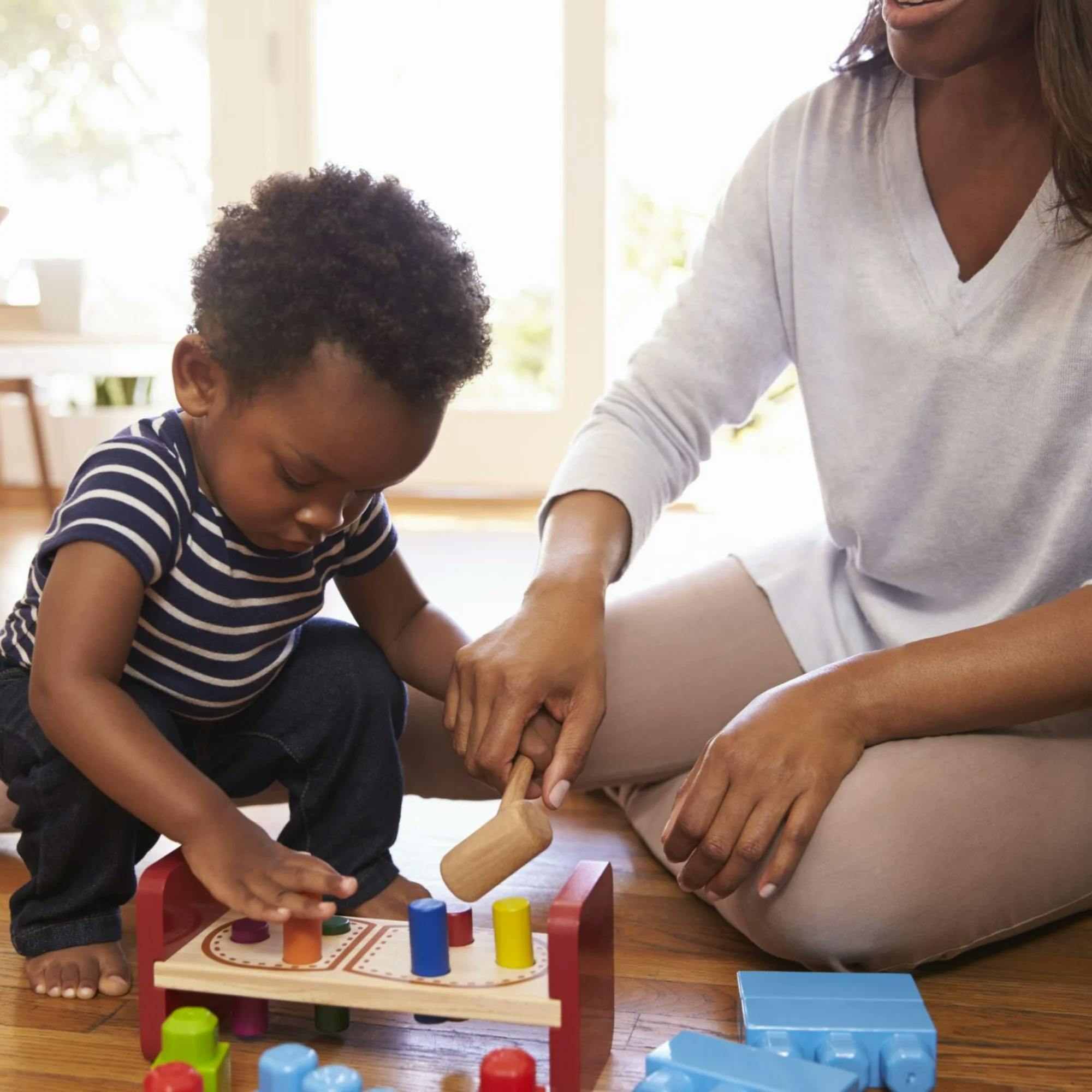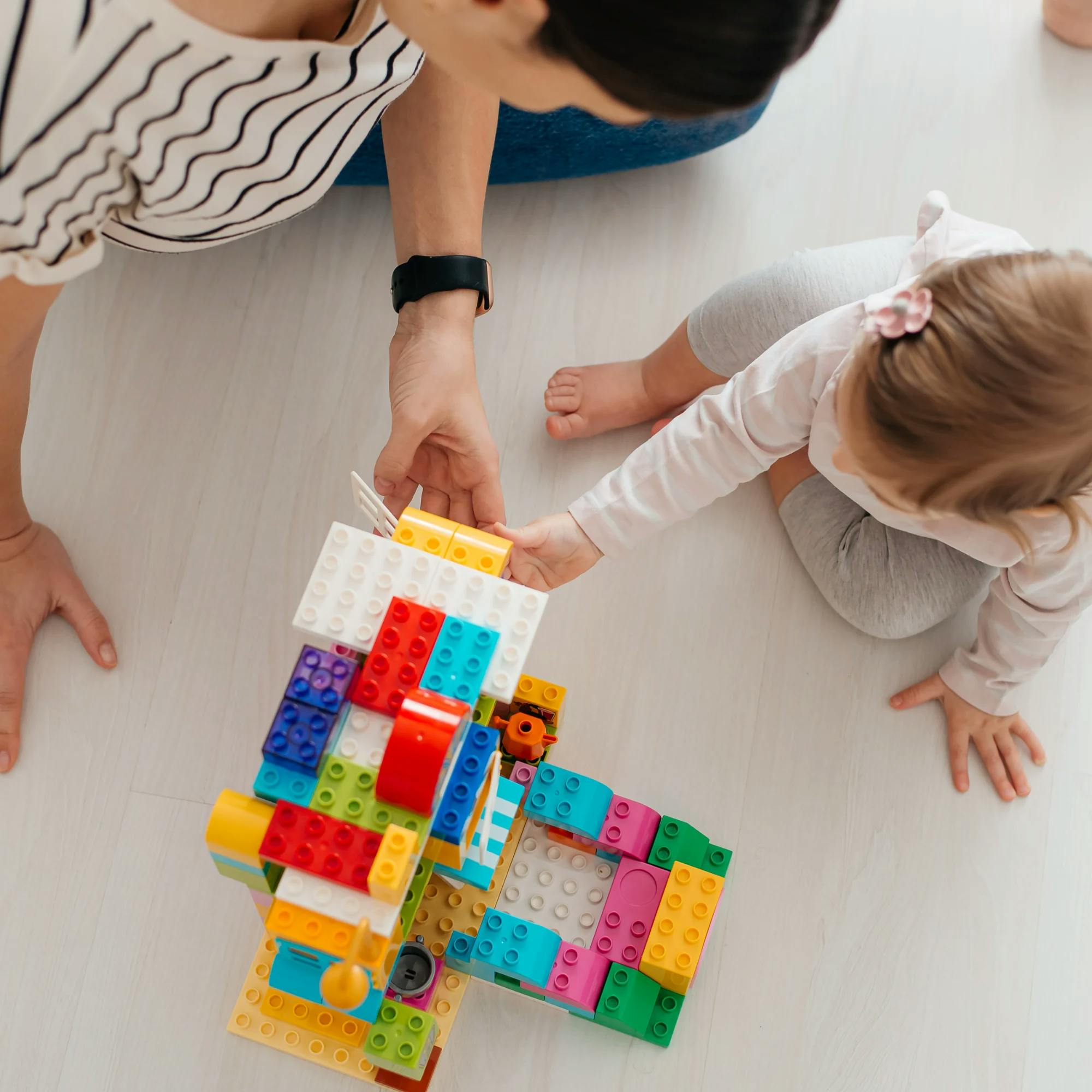
The Busy Parents’ Guide: 5 Ways to Practice Speech During Daily Routines
 Abby Barnes, M.S., CCC-SLP
Abby Barnes, M.S., CCC-SLP
We know families are on the go. Between work, juggling everyone's schedule, driving kids to school and activities, and running errands, the days are usually packed full.
So how do you find time to help your child learn to talk? After all, the more caregivers take the time to meaningful interact with their kids, and practice their foundational speech and language skills, the quicker they'll reach developmental milestones.
Here's the good news: Practice doesn't have to be a scheduled event throughout the day. In other words, practice can happen in everyday exchanges with your child, during activities you're already doing: eating breakfast, getting dressed, riding in the car. It simply takes finding the right opportunities and knowing how to interact with your child to create natural, language-building moments.
If you're a busy caregiver looking to help your child say their first words or keep learning new ones, you've come to the right place! So let's jump in.
Curious or concerned?
Our free screener is tailored by age and covers all areas of speech, language, and feeding. Find out if your child might need speech therapy.
 Screener for children
Screener for children1. Morning routine
Start off the day by providing lots of opportunities for communication! There are so many ways you can easily incorporate early language skills into morning routines. Let’s go over a few.
Did you know that music is a great way to promote language growth? Pausing during songs and encouraging your child to fill in the blanks is a great activity to increase expressive language. Try singing some fun songs during breakfast. For example, you can sing songs like, “I like to eat, eat, eat, apples and bananas,” but fill in the blank with the foods your child is actually eating. Pause after you sing, “I like to eat, eat, eat…” and see if your child will label their breakfast food for you. (Watch a quick demo from one of our speech therapists here!)
After breakfast, when getting your child dressed for the day, offer them choices about what they'd like to wear. Providing choices is a powerful way to promote language development because it gives your child a taste of independence. Communicating what they want, and then receiving that item, creates a reward structure that can encourage them to speak more. You can learn more about offering choices here. Here's an example you could try: While helping your child get dressed, present two different shirts. You can say, “Would you like the blue shirt? Or the red shirt?” Pause, wait, and see if your child responds. If they usually only gesture and point, then prompt them to imitate the name of their desired shirt color. If they typically only give you a one-word answer (like "blue"), prompt them for a two-word phrase (like "blue shirt"). You want to work just one level above where your child is currently performing.
2. Driving in the car
Maybe you're going to daycare, school, or the grocery store. Wherever you go, use this valuable time to your advantage! Here are a few ways you can practice.
Try targeting concepts like "stop" and "go." When you stop the car, you can say, “Stop! The car stopped!” When it’s time to drive, say, “Go! Go car!” See if your child will imitate these phrases. Your child may even begin independently saying, “Go!” or “Stop!” over time. Teaching words in this way increases the chance that your child will begin using them independently.
Model some non-speech sounds for your child to imitate. If you hear a horn, say, “Beep! Beep!” Or if you hear a loud engine, then model, “Vroom vroom!” Sometimes, young children are more likely to imitate non-speech sounds. This is a perfect stepping stone if your child isn't yet talking much.
While driving in the car, you can continue to use music and nursery rhymes to promote language growth. The great thing about singing and talking together in the car is that your child is buckled in--they can’t go anywhere! You get their full attention and can pass the time with a rewarding activity.

3. At the grocery store
Here are some fun ways you can target language skills at the grocery store.
When you go through the produce aisles, make it a point to teach different colors to your child. You can talk about red apples, yellow bananas, green grapes--anything you see! Not only will your child be learning their colors, but they may even begin to use these words in their everyday speech.
As you shop and find each item on your list, have your child label the item, or use it in a phrase before you put it in the cart. You can tell your child, “I need your help! What is this?” and point to the item on the shelf For this example, we'll focus on bread. See if your child will name the bread, or even use it in a short phrase like, “Get the bread!” or “We need bread!” Once they give you a verbalization, give them a high five and put the item in the cart. By feeling like they're helping you shop, they may be more motivated to communicate.


4. Playing outside or at the park
Fresh air and physical activity is a huge benefit for children. It’s no surprise that there are a ton of engaging ways to incorporate speech goals while playing outside!
Swinging is the perfect activity to target verbalizations. As you push your child on the swing, grab the swing and wait. See if your child requests, “More!” or “Go!” before you reward them with a push. For added cueing, you could model, “Ready, set, ....” and see if your child fills in the blank with, “Go!”
You can target some fun animal sounds while playing outside. Again, practicing non-speech sounds may be easier for children than producing real words, so it's a great first step! If you see a dog on a walk, ask your child, “What does the dog say?”
Continue to offer your child choices about playtime activities. This could be something like, “Do you want to play on the swing, or go on the slide?” This is a natural context for your child to communicate, and one that's very rewarding. This is referred to as a communication temptation. Check out this article to learn more about communication temptations.
5. Nighttime routine
While the day may be coming to a close, that doesn't mean speech practice has to end! There are many ways to promote language growth during your child's bedtime routine.
Bath time is a great chance to target speech and language skills. You can teach concepts like “On” and “Off” by turning the faucet on and off. You can even target concepts like “Wet” and “Dry” and “In” and “Out.”
This is also a good time to practice word/phrase imitations. Your child is right there in the tub and can’t run away! You can have their full attention. You can use their bath toys during practice to keep it fun and playful.
Read a book with your child before bed. Reading allows your child to hear new vocabulary and learn correct sentence structure. Ask your child to identify different items in the pictures to target receptive vocabulary. You can then ask them to name the items to target expressive vocabulary. Here are some helpful ways to make reading fun and enjoyable for your child! For children who are already using some phrases, you can ask a question like, “What do you see in the picture?”

Find out if your child is on track with their speech and language
You know your child best. Think about what communication skills will benefit your child most, and how you can naturally weave them into their day. It isn’t hard--it just takes some creativity. Over time it will feel more natural to add speech practice to your child's everyday routines.
Curious or concerned about your child's speech development? Take our easy online screener. The questions are tailored to your child's age, and you'll receive detailed results that explain whether an evaluation is recommended.
How Expressable Can Help
Concerned your child isn't reaching age-expected milestones? Looking for communication support from a professional? Expressable is a national online speech therapy practice serving children and adults. We treat all major areas of communication and feeding, offer flexible hours including evenings and weekends, and accept most major health insurance plans. We’re proud to have earned more than 3,000 5-star reviews from our clients (4.9/5 average).
Our therapy model is centered on parent and caregiver involvement. Research proves that empowering caregivers to participate in their loved one’s therapy leads to better outcomes. That’s why we combine live, 1-on-1 speech therapy with personalized education and home practice activities for faster progress.
Communication is more than words. It’s how we share how we feel and show who we are. We’re here to help you or your child do just that.











